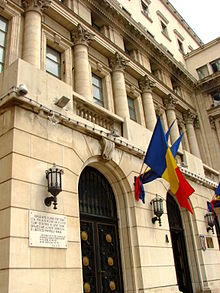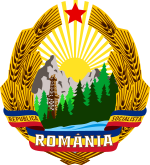| Revision as of 09:19, 12 September 2013 editYobot (talk | contribs)Bots4,733,870 editsm WP:CHECKWIKI error fixes using AWB (9475)← Previous edit | Revision as of 23:00, 13 September 2013 edit undoHangingCurve (talk | contribs)Autopatrolled, Extended confirmed users, Pending changes reviewers, Rollbackers101,109 edits heavy rewriteNext edit → | ||
| Line 1: | Line 1: | ||
| {{multiple issues| | |||
| {{POV|date=August 2013}} | |||
| {{one source|date=August 2013}} | |||
| {{primary sources|date=August 2013}} | |||
| {{too few opinions|date=August 2013}} | |||
| }} | |||
| ] | ] | ||
| {{Communist Romania}} | {{Communist Romania}} | ||
| '''Ceaușescu's final speech''' is a speech delivered by ]n ] ] on 21 December 1989. It was one of the most decisive moments in the ]. | |||
| In the wake of growing tension over an uprising in ] in which thousands were reportedly killed, Ceauşescu decided to give a nationally televised speech before a crowd in Palace Square (now known as ]. This speech was an annual event and carefully scripted by the regime to insure both success and the appearance of popular support. | |||
| This speech to a crowd of 80,000 in ] was an annual event and carefully scripted by the regime to insure both success and the appearance of popular support. Workers, military units and other popular organizations were bused to the capitol and given orders on where to stand, when to applaud and what to sing. Ceausescu begins his address to the people as he had in years past but this year the tide turned. | |||
| Thousands of workers were bused into the square under threat of being fired. They were given red flags, banners and large pictures of Ceauşescu. They were augmented by several bystanders who were rounded up on Calea Victoriei.<ref name=Revolution1989>{{cite book|last=Sebetsyen|first=Victor|title=Revolution 1989: The Fall of the Soviet Empire|publisher=]|location=New York City|year=2009|isbn=0-375-42532-2}}</ref> They were given orders on where to stand, when to applaud and what to sing. | |||
| This year, the crowd begins to chant unscripted comments back at the dictator. As the crowd becomes more unruly, Ceausescu becomes more confused and he begins arguing with the unseen hecklers. His security guard appears, disappears and, finally, hustles Ceausescu off the balcony. It is as if, in that moment, everyday Romanian's saw the possibility, saw the reality of the weakness of Ceausescu’s regime.<ref></ref> | |||
| Ceaușescu appeared on the balcony of the Central Committee building and began as he had in years past, with a speech laden with the usual ] "]." However, he had badly misread the crowd's mood. Only the front rows supported Ceauşescu with cheers and applause, with most of the crowd remaining impassive. Eight minutes into the speech, some in the crowd actually began to jeer, boo and whistle at him—a reaction considered unthinkable for most of Ceauşescu's 24 years in power. Workers from a Bucharest power plant started chanting "Ti-mi-şoa-ra! Ti-mi-şoa-ra!"—a chant that was soon picked up by others in the crowd. In response, Ceauşescu raised his right hand in hopes of silencing the crowd; his stunned expression remains one of the defining moments of the end of Communism in Eastern Europe. He then tried to placate the crowd by offering to raise workers' salaries by 100 ] per month (about 9 ] at the time, yet a 5–10% raise for a modest salary) and student scholarships from 100 to 110 lei while continuing to praise the achievements of the past 42 years. He did not realize, however, that a real revolution was starting before his eyes.<ref name=Revolution1989/> | |||
| His security guard appeared, disappeared and, finally, hustled Ceausescu off the balcony. At that very moment, many everyday Romanians saw the weakness of Ceaușescu's regime for the first time.<ref></ref> | |||
| ==References== | ==References== | ||
Revision as of 23:00, 13 September 2013

| Part of a series on the |
| Socialist Republic of Romania |
|---|
 |
| Organizations |
| Leaders |
| Ideology |
| Policies |
| Culture |
| Repression |
| Protests and resistance |
| Relationship with the USSR |
| Relations with other states |
Ceaușescu's final speech is a speech delivered by Romanian dictator Nicolae Ceauşescu on 21 December 1989. It was one of the most decisive moments in the Romanian Revolution of 1989.
In the wake of growing tension over an uprising in Timişoara in which thousands were reportedly killed, Ceauşescu decided to give a nationally televised speech before a crowd in Palace Square (now known as Revolution Square. This speech was an annual event and carefully scripted by the regime to insure both success and the appearance of popular support.
Thousands of workers were bused into the square under threat of being fired. They were given red flags, banners and large pictures of Ceauşescu. They were augmented by several bystanders who were rounded up on Calea Victoriei. They were given orders on where to stand, when to applaud and what to sing.
Ceaușescu appeared on the balcony of the Central Committee building and began as he had in years past, with a speech laden with the usual Marxist-Leninist "wooden language." However, he had badly misread the crowd's mood. Only the front rows supported Ceauşescu with cheers and applause, with most of the crowd remaining impassive. Eight minutes into the speech, some in the crowd actually began to jeer, boo and whistle at him—a reaction considered unthinkable for most of Ceauşescu's 24 years in power. Workers from a Bucharest power plant started chanting "Ti-mi-şoa-ra! Ti-mi-şoa-ra!"—a chant that was soon picked up by others in the crowd. In response, Ceauşescu raised his right hand in hopes of silencing the crowd; his stunned expression remains one of the defining moments of the end of Communism in Eastern Europe. He then tried to placate the crowd by offering to raise workers' salaries by 100 lei per month (about 9 U.S. dollars at the time, yet a 5–10% raise for a modest salary) and student scholarships from 100 to 110 lei while continuing to praise the achievements of the past 42 years. He did not realize, however, that a real revolution was starting before his eyes.
His security guard appeared, disappeared and, finally, hustled Ceausescu off the balcony. At that very moment, many everyday Romanians saw the weakness of Ceaușescu's regime for the first time.
References
- ^ Sebetsyen, Victor (2009). Revolution 1989: The Fall of the Soviet Empire. New York City: Pantheon Books. ISBN 0-375-42532-2.
- Video of Ceausescu’s Last Speech, December 1989
External links
- Template:Ro icon Nicolae Ceausescu's final speech, 1989 [EN SUBTITLES]
- Template:Ro icon Nicolae Ceaușescu LAST SPEECH (english subtitles) 1/2